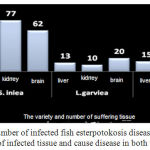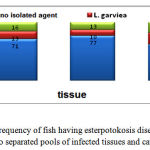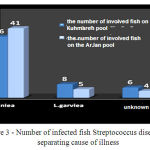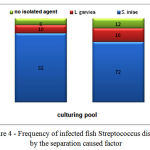Sadeghi Limanjoob Reza1*,Farzam Mohsen2 ,Jamali Houshang3 , Syahmard Nahid4, kargar Jahromi Hossein5 and Farzam Mohammad2
1Department of Aquatic Animal Health, Veterinary School, Kazerun Branch, Islamic Azad University, Kazerun, Iran.
2Department of Physiology, Veterinary School, Kazerun Branch, Islamic Azad University, Kazerun, Iran.
3Department of Microbiology, Jahrom Branch, Islamic Azad University, Jahrom, Iran.
4Department of Physiology, Medical School, Kazerun Branch, Islamic Azad University, Kazerun, Iran.
5Zoonoses research center, Jahrom University of Medical Sciences, Jahrom, Iran.
DOI : https://dx.doi.org/10.13005/bpj/494
Abstract
Due to increasing human needs, especially food sources of protein and with regard to the very top of the food value of fish as a good protein source, we see today spread over the loss of water aquaculture industry, especially culturing fish. Intensive fish culture techniques in order to save space and costs, has caused so many kinds of natural pathogens, the pathogens are raised as fish diseases, losses or reduce the efficiency or create losses in the fish impose the occasional aquaculture industry on the world. According to the above aim of the present is studying esterpotokosis disease of rainbow trout breeding farms. A total of 100 samples of alive fish that has symptoms similar to the esterpotokosis disease on Arjan plain in Fars Province Were caught and after necropsy tissue, kidney, liver and brain samples of bacteria on blood agar medium (BA) was performed. Sampling was conducted in the vicinity of the flame and sterile equipment. Samples to the laboratory of Veterinary Medicine, University of Kazarun was moved into the incubator temperature was maintained at 25 ° C for 72 hours. After this period, first by performing Gram staining, catalase test, Gram-negative samples was removed and additional biochemical tests after re-cultures of samples were performed on them. The results showed that the isolates samples were of the two species S.iniae and L.garviae. The amount of fish with clinical signs of infection was S.iniae and 75% L.garviae 20% and 5% of cases were identified. Isolation level S.iniae bacteria of Kidney tissue, Brain, and Liver respectively were 77%, 62% 71% and L. Garviae of Kidney tissue, Brain, liver, were respectively, 10%, 20%, 13%. According to previous research results show that the disease is chronic and there are in Fars province farms and must do something fundamental and surveying to eradicate the disease from the farm.
Keywords
Esterpotokosis disease; Trout; Rainbow; Shiraz
Download this article as:| Copy the following to cite this article: Reza S. L, Mohsen F, Houshang J, Nahid S, Hossein K. J, Mohammad F. The Study of Investigating Catching Rate of Esterpotokosis Disease on Breeding Farms of Rainbow Trout (Onchorhynchus mykiss) Arjan Sector of Shiraz City. Biomed Pharmacol J 2014;7(1) |
| Copy the following to cite this URL: Reza S. L, Mohsen F, Houshang J, Nahid S, Hossein K. J, Mohammad F. The Study of Investigating Catching Rate of Esterpotokosis Disease on Breeding Farms of Rainbow Trout (Onchorhynchus mykiss) Arjan Sector of Shiraz City. Biomed Pharmacol J 2014;7(1). Available from: http://biomedpharmajournal.org/?p=2977 |
Introduction
Due to the increasing human needs, especially food sources of protein and with regard to the very top of the food value of fish as a good protein source, we see today spread over the loss of water aquaculture industry, especially breeding fish culturing . This high growth Together with intensive fish production methods in order to save space and costs has caused so many kinds of natural pathogens, be the pathogens, or creating losses, of fish and reduce the efficiency of time to time impose the fish losses in the aquaculture industry in the world (1).
In the recent years due to increased productivity in the aquaculture of some pathogens, have been involved the opportunity to create and in Iran farming culture since the disease can Pointed out esterpotokosis ” pop eye ” that were reported at the beginning of some salmon farms in the Shiraz province (1). esterpotokosis disease is An infectious bacterial disease of cultured and wild fish diseases in freshwater, saltwater and brackish throughout the world., Which by bacteria Gram-positive Spherical or oval forms Streptococcus and Lactococcus are caused by the presence of disease-causing species diversity in most recent aquatic species Streptococcus enyieh role has been confirmed (2).
After the occurrence of the disease was first reported in 1958 by Hushyna, this disease distributing in the years 1966, 1972, 1974 America was reported and casualties were established up 50% on the beaches of Florida (3, 4). Then rainbow trout individually and pandemic disease Saltwater and freshwater fish farmed in many parts of the world has happened.
Damage caused by this disease in recent years, has faced Japanese yellow tail fish Gish with a serious threat.
This Disease in marine fish such as Mugil cephalus, Brevoortia patronius, and Arius-Felis, Lagodon rhomboids, Micropogon undulatus have also been reported (5). Lahave and colleagues (2004) were able to isolate S. enyieh of rainbow trout (6). Lau Et al (2002) reported infection in two Chinese people living in America who one leads to cellulite and other bacterial osteomyelitis (7). The incidence of this disease in rainbow trout farms in South Africa have also been reported in gas supersaturated water (8).
enyieh was first isolated of Amazon freshwater dolphin injuries (9). Then the bacteria isolates causing septicemia and meningitis in some farmed fish species such as rainbow trout and yellow tail Gish were isolated (10-12). This bacterium in people with a history of fish manipulating in America and Canada who has cellulite sympathies were observed (14, 13). So these bacteria should be considered as a zoonotic pathogen. Despite S. enyieh in terms of the phenotype is detected properly but there is a high degree of similarity with other streptococcal species. For example, according to reports, many similarities between the Oberis bacterial of Streptococcus species have been observed. [14] In 1994, a new species of Streptococcus with different characteristics from isolated of rainbow trout fish was reported in Israel and the name of the species Streptococcus was called S.shiloi that the disease it is caused has significant economic losses in the aquaculture industry in Israel Blast (12). Subsequent studies with similar results of Israel isolate and the United States based on genetic and biochemical studies, the bacterium Streptococcus enyieh introduced a prototype very similar with the two bacteria that now is known as a species of Streptococcus (15).
Lactococcus Garvieh first time in Great Britain was isolated from bovine udder infections (16). Later this disease bacterium isolated from a variety of freshwater fish and saltwater and humans have been identified (12). This caused an Increasing importance as a pathogenic pathogen bacteria in fish first and second as a zoonotic agent ‘s. these bacteria based on genetic and biochemical studies has similarity with lactis Lactococcus subspecies lactis strains that The latter bacterium as a human pathogen has been introduced (12, 16, 8).
For various reasons, many of today’s rainbow trout farms in other areas such as Kuhkiloyeh and bouyer Ahmad this disease is detectable. According to the above discussed cases it seemed that the longer the disease and to identify the causes of it, has a more extensive study on the incidence and spread of disease status of esterpotokosis than done, but the results can help to the all provincial veterinary practitioners to appropriate measures to combat the spread of the disease and the ways to fight more successfully with this disease.
Methods
After having made arrangements with Arjan regional aquaculture and fish samples were taken of Kuhmareh city of Shiraz. It should be noted, all or just some sampling fish of the symptoms of suspected disease were done and this at least about 50 fish per workshop (Total 100 fish) was done. Because the best specimens for bacteriological studies were alive, all sample preparation was necessary before that the fish will be alive, the daily losses for the sample collected at the site was not used and only the sampling was done of alive fish. Thus, after determining the fish in the ponds, with Sachuk nets were fished. Fishing this kind due to disability of fishes and its separating from others is easily possible to measure than others. These fish in the water extract of clove as a calming agent in a bucket with a capacity of approximately 20 Liter were sent to the office of the workshop .at this stage apparent examination of the action was Fish and symptoms stating disease were recorded. Then the pieces of fish were captured separately. Similarly, necropsy observations were taken and Bacterial samples were taken from fish immediately. To do this immediately after the death of all fish parts a) kidney b) brain c) liver biopsy was performed. It took quite sterile.
Immediately after preparation, Samples on blood agar medium (BA) were inoculated with the flame. Then onto plates containing medium number of workshop participants was recorded. Inoculated Plate immediately were sent to the bacteriology laboratory., In this study, the Center laboratory for Veterinary Medicine, Azad University of Kazeroon for isolation and identification , to do subtraction sample was put into operation. Gram staining was performed to detect the initial samples and negative samples were removed. Then with purified target (Purification ) First of all colonies with Appearance characteristics listed above re- passage was taken and And per plate To determine the morphology and Gram smear features Prepared and Gram staining was performed And were examined under a light microscope. Then enjoying, main sources of Bacteriology attempt to adjust protocol vitro biochemical studies to achieve an isolates classification position (Taxonomy).
Results
Table 1 results obtained from Differential biochemical experiments
| Place of sampling | isolated Bacterial species | Total | ||
| S. iniea | L. garviea | Unknown | ||
| Arjan pool | 41 | 5 | 4 | 50 |
| Kuhmareh Pool | 36 | 8 | 6 | 50 |
Based on these results and According to Table 1, which show Differential biochemical properties of the bacteria that because the esterpotokosis rainbow trout on hot water, it seems that the isolated bacteria from infected fish on the studied farms mainly of eniyeh Streptococcus and are also number of Garvieh Lactococcus.
 |
Figure 1: Number of infected fish esterpotokosis disease compared to separation of infected tissue and cause disease in both the total pool
|
With attention to figure (1) Isolation rate of S.iniae from Kidney, Brain and Liver tissue were respectively 77%, , 62% 71% and L. Garviae of Kidney, Brain, liver, tissue were respectively, 10%, 20%, 13%.
 |
Figure 2: Frequency of fish having esterpotokosis disease with the sum of two separated pools of infected tissues and cause disease
|
 |
Figure 3: Number of infected fish Streptococcus disease by separating cause of illness
|
 |
Figure 4: Frequency of infected fish Streptococcus disease by the separation caused factor
|
These results suggest that esterpotokosis disease, particularly( S. iniae ) species are the most and the main factors causing secondary infections in both pools but the amount of risk of having disease among sick fish ponds of Arjan area was higher (more than 80% Compared with pool Kuhmareh about 70% Respectively).
Discussion
As mentioned esterpotokosis disease as an important bacterial disease in more than 22 species of farmed fish in the world has the variety and great economic losses (17). Yet mechanisms of diseases caused by these organisms in fish are unknown. However it is believed that the pathogenesis and fatalities caused by exo-toxsins bacteria, such as streptokinase (To digest fibrin), esterpetodernaz (causing breakdown DNA Comes cellular) is hemolysin and hyaluronidase (2). Exophthalmia that surround this disease appears to be caused by hyperemia and edema of the back of the eye area, and it usually leads to cellular inflammation with the influence of necrotic as well as embrace the optic nerve and choroid and expands into eye socket. Gradually hyperemia and hemorrhage occurred on Retinal vessels, necrosis, necrotic material exiting through the lens of the eye and even corneal ulcers continues. (18, 19).The cause of death could be due to excessive bleeding at the gills hyperemia, infiltration of macrophages and the necrotic gill tissue. (19)
In Iran The first isolation of these bacteria in fish feeding of Rainbow trout patients was taken in Mazandaran province by analogy, et al (1379) (20)., In May 2001 the moral Streptococcus and agriculture of the province are reported one of the TROUT Education Workshops ‘s. Bacteria In Turkey bacterium Lactococcus Garviae in the spring of 2001 caused 80% mortality in rainbow trout farms (21) And Streptococcus agalactiae in Kuwait sea mullet by mortality of 90% has been recorded (22). It is based on molecular epidemiological studies performed by Haghighi and colleagues (2010) isolated Streptococcus eynieh of farms in seven provinces That have country’s largest producer of cultured salmon Most genetic affinity with the strains recorded in East Asia (23). It is well known in the world with this bacterium Lactococcus Garvieh and other species of the Streptococcus as the pathogen causing the disease in fish are listed. Including Elder Et al (1996) esterpotokosis were introduced as the main cause of death in infected fish (18).
Several studies by scientists on many factors influencing the occurrence and severity of the disease in the country were done and a major cause of bacterial pathogens involved as a major has been identified as Streptococcus eynieh (24). Since such an investigation conducted by the Tarahomy and colleagues in 2006 refers to the presence of the bacteria Streptococcus Lactococcus eynieh and Garvieh of farms in the Beiza section of Fars province (1) and also Ethical and agriculture report as well as in 2002 of infection breeding pools over 95 percent in the city of Shiraz, and more than 65 percent of city pools of MARVDASHT to Streptococcus (25) That has clear and significant similarities results with the results of the study, the percentage of patients ahead Esterpotokosis precedent to an average of 75% to 20% and people having Garvieh Lactococcus which was unknown was reported 5%. However, on the Tarahomy study on 2006 no bacteria isolating that could be classified under the genus Streptococcus or Lactococcus originated from wild fish rainbow trout farms in Beiza section of Fars province wasn’t reported (1).
According to the results of the present study it seems that isolated from fish studied with most studies are consistent. While the frequency of eynieh Streptococcus and Lactococcus Garvieh Respectively 75 and 20 per cent that has more consistent Akhlaghi studies (2002) and Tarahomy and colleagues (2006)
Even assuming the transmission of disease from wild fish ponds, water resources, esterpotokosis disease prevalence observed in this study could be due to other environmental and human factors such as excessive plant growth in ponds water resources due to the exposure pool Location ,since the lack of sun shade, especially in hot seasons, as a major environmental and human factors such as the presence of a significant population of nearby residents on edge of swimming pools and supplies water of Arjan especially in the area of resolution in where It was reported streptococcal agent., and cattle nomads of the sources of water supply, water pools, causing permanent and widespread presence of these secondary factors, particularly in the hot season, that is the ideal season for the year is the other factors of the disease human ‘s.
So far, most studies have been performed in order to detect and identify the pathogen that has been based Virulence factors (21, 24). However, given that the disease is considered worldwide as a secondary disease and environmental factors play a fundamental role in the occurrence and intensity of conflicts of esterpotokosis. [18] as well as the disease as a cause of zoonotic is discussed and reports of fish caught have been in contact with infected persons are listed (26). Therefore, the disease and its spread across the country (which we see today) can serve as an important disease threatening the Iran aquaculture industry in the present and the future course to be considered more broadly. Moreover, a study on the pathogenicity of Streptococcus pneumonia virulence eynieh on the salmon was done; It was observed that This bacterium Has great potential In making sick the fish so The lack of understanding of the condition In the country Could Spread this disease cause Frequent adverse effects (21, 24).
The identified Pathogen in this study is specifically Streptococcus eynieh as one of the main Gram positive bacteria causing the disease esterpotokosis on hot water (Above 15 ° C) in the world (29, 27). Survival of this pathogen in the mud surrounding fish farms, Water and mud seafloor is observed even for a year (28). In addition, the most sensitive fish species to the disease is Rainbow trout that In Iran is one of the most important farmed fish (2). Given the importance of environmental factors in the disease, proposals will focus more on the basis of these factors.
Conclusions
According to studies done by the eynieh bacterium Streptococcus, most likely in involving fields of study fish is the main pathogen. Possible survival of bacteria in the farm environment is such that even 4-month stay dry ponds and disinfection of the pool is not complete before the introduction of fry fish to prevent conflict again. Accordingly, it is necessary that relevant organizations and officials with benefiting from the results of this study and other relevant researches try to overcome the problems caused by the esterpotokosis increasing disease. In this regard, to disinfect the water before the fish and pathogen exposure, Traffic controlling of equipment and people to the workshop, avoiding any kind of interference in the ponds, and cause stress, health and scientific observing on the preparation of the diet, raising academic standards to the circumstances workshop, Timely and appropriate use of antibiotics under the supervision of an expert, Mandatory use of appropriate vaccines against esterpotokosis of fish and larger studies in the field of epidemiological diseases can reduce the symptoms and fish culture.
References
- Tarahomi, Mohammad., Soltani, Mehdi., (1385): studying the status of streptococcal infection in rainbow trout farms in Beyza area of Fars Province, PhD Thesis, Islamic Azad University, Science and Research Branch, Tehran, Page 50-1.
- Austin, B., and Austin, D.A., (1999): Bacterial fish Pathogens.Disease of famed and wild fish.Springer/praxis publishing.chichester.
- Plumb, J.A., Schachte, J.H., Gaines, J.L., Peltier, W., and Carrol, B., (1974): Streptococcus sp.From marine fishes along the Alabama and northwest Floride coast of the Gulf of Trans.Amer.Fish.Soc.103:358-361.
- Robinson, J.A., and Meyer, F.P., (1966): Streptococcal fish pathogen .J.Bacteriol.92:512.
- Kusuda, R., Kawai, K., Salati, F., Banner, C.R., and Fryer, J.L., (1991): Enterrococcus seriolicida sp.nov.,fish pathogen.Int.J.syst.Bacteriol.41:406-409.
- Lahave, D., Eyngor, M., Hurvitz, A., Ghittion, C., Lublin, A., Elder, A., (2004): Streptococcus iniae typrii infection in rainbow trout (oncorhynchus mykiss).Dis .Aquat organ.,62(1-2):177-180.
- Lau, S.k.P., Woo, P.C.Y., Tse, H., Leang, K.W., Wong, S.S.Y., Yuen, K.Y., (2002): Invasive Streptococcus iniae infection outside north America Journal of Clinical Microbiologe.,41(3):1004-1009.
- Mannion, P.T., and Rothburn, M.M., (1990): Dagnosis of Bacterial endocarditis caused by Streptococcus lactis and assisted bu immunoblotting of serum antibodies,J.infect .21:317-318.
- Pier, G.B., and Madin, S.H., (1967): Streptococcus isolated from an Amazon freshwater dolphin, Inia geffrensis.Int.J.Syst.Bacteriol.26:545-553.
- Perera, R.P., Johnson, S.K., Collins, M.D., and Lewis, D.H., (1994): Streptococcus iniae associated with mortality of Tilapia nilotica x T.aurea hybrids .J.Aquat .A.Anim Health .6:335-340.
- Stoffregen, D.A., Backman, C., Perham, R.E., Bowser, P.R., and Babish, J.G., (1996): Initial disease report of Sterptococcus iniae infection in hybrid striped (sunchine) bass and successful therapeutic intervention with the fluoroquinolone antibacterial enrofloxacin. J. World Aquacult .Soc.27:420-434.
- Elder, A., Bejerano, y., and Bercovier, H., (1994): Streptococcus shiloi and Streptococcus difficile: two new Streptococcal species causin meningoencephalitis in fish.Curr.Nicrobiol.28,139-143.
- Berridege, B.R., Fuller, J.D., Azavedo, J., Low, D.E., Bercivier, H., and P.J., (1998): Development of specific nested oligunucleotide PCR primers for the streptococcus iniae 16s-235 ribosomal DNA intergenic spacer.J.clin.Micropiol.36,2778-2781.
- Weinstein, M.R., Litt, M., Kertesz, D.A., Wyper, P., Rose, D., Coulter, M., Mcgeer, A., Facklam, R.R., Ostach, C., Willey, B.M., Borezyk, A., and Low, D.F., (1997): Invasive infections due to a fish pathogen,Streptococcus iniae. N. Engl. J. Med. 337: 589-594.
- Elder, A., Frelier, P., Assenta, F., L.Varver, P.W., Lawhon, S., and Bercovier, H., (1995): streptococcus Shiloi, the name for an agent causing septicemic infection in fish,is a junior synonym of Streptococcus iniae.Int .J.Syst.Bacteriol,45,840-842.
- Collins, M.D., farrow, F.A.E., Philips, B.A., and Kandler, O., (1984): streptococcus garvieae sp.Nov.and streptococcus plantarum sp.Nov .J.Gen.Microbiol.129,3427-3431.
- Klesius, P.H., Shoemaker, A., Evans, J.J., (2002): Streptococcus iniae vaccine ,U,S.patent 6,379-677 B1.
- Elder, A., Ghittino, C., Asanta, L., Bozzetta, E., Goria, M., and Bercovier, H., (1996): Enterococcus seriolicida is a junior synonym of Lactococcus garvieae ,a causative agent of Septicemia and meningoencephalitis in fish.Curr.Microbiol:32,85-88
- Michel, C., Nougayrede, P.E., ldar, A., Sochon, E., and de kinkelin, P., (1997): vagococcus salmoninarum .A bacterium if pathological significance in rainbow trout (oncorhynchus mykiss)farming .Dis ,aquat.Org .30:199-208.
- Alishahi, Mojtaba., (1385): Studying effectsof protectionandadministration ofimmunogeniccelldeath anddeadcellsenriched withextracellularproductsof Streptococcusiniae (S.iniae)inrainbowtrout(O.mykiss),theaPhDTehran University,page
- Fadaei Fard, Firuz., (1384) Comparison of bacterial pathogenicity of Streptococcus iniae isolated and semi Yersinis ruckery in rainbow trout, PhD Thesis, Islamic Azad University, Science and Research, page 96.
- Bachrach, G., Zlotkin, A., Hurvitz, A., Evans, D.L., Elder, A., (2001): Recovery of Streptococcus iniae from diseased fish previously vaccinated with a Streptococcus vaccine.Appl.Environ.microb.;67:3,8-756
- Haghighi karsidani, S., et al., (2010): Molecular epidemiology of zoonotic Streptococcosis / Lactoccosis in rainbow trout (oncorhynchus mykiss) aquaculture in Iran;Iran J Microbiol; 2(4):198-209.
- Soltani, Mehdi., (1380): Diseasessalmon, writing, Tehran University Press, pp. 42-37.
- Akhlaghi, A., Mahjor, A., (2004): somehistopathological aspects of Streptococcosis in cultured rainbow trout (oncorhynchus mykiss), European Association of fish pathologists, 24(3):24-32
- Zlotkin, A., Hershko, H., and Elder, A., (1998): Possible transmission of Streptococcus iniae from wild fish to cultured marine fish .Appl,Environ ,Microbiol ,64:4065-4067.
- Boomker, J., imes, G.D., Camsron, C.M., Naude, T.W., and Schoonbee, H.J., (1979): Trout mortalities as a result of streptococcus infection,onderstepoort J.Vet ,Res ,46,71-77.
- Kitao, T., Aoki, T., and sakoh, R., (1981): Epizootics caused by B-haemolytic Streptococcus species in cultured freshwater fish.Fish pathol.15:301-307.
- Robinson, J.A., and Meyer, F.P., (1966): Streptococcal fish pathogen .J.Bacteriol.92:512.







